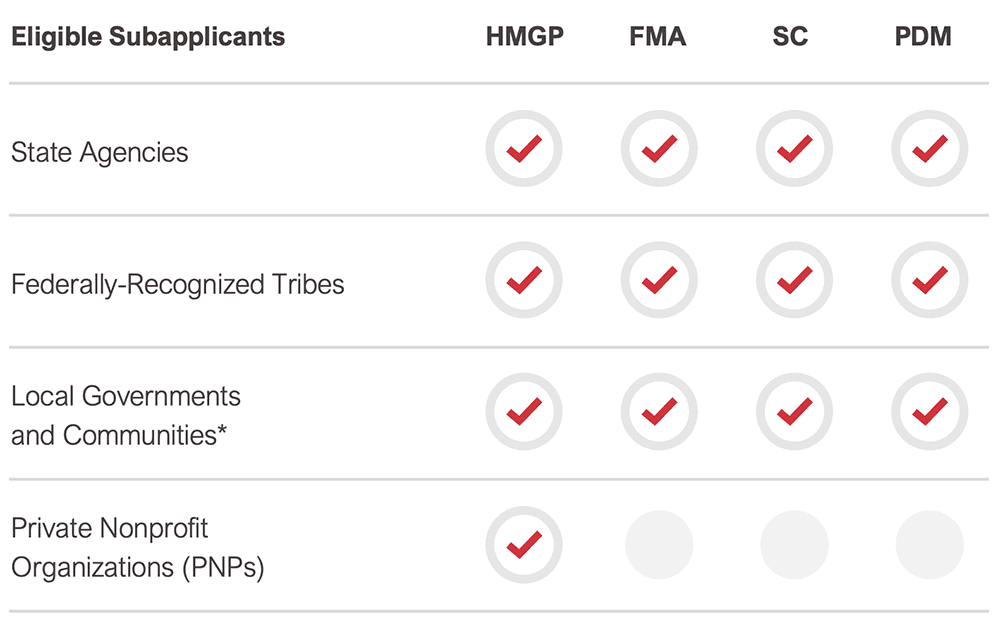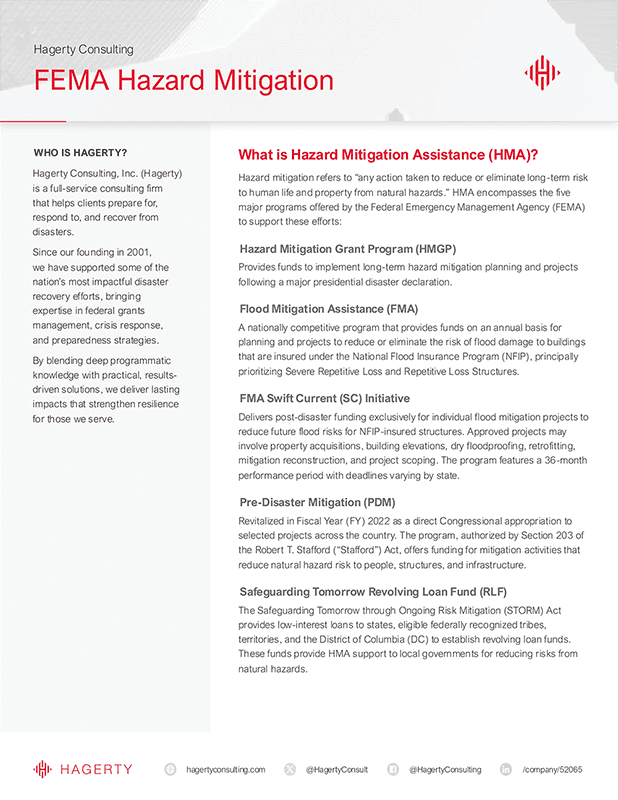What Is Hazard Mitigation Assistance (HMA)?
Hazard mitigation refers to “any action taken to reduce or eliminate long-term risk to human life and property from natural hazards.” The Federal Emergency Management Agency (FEMA) addresses these needs through its Hazard Mitigation Assistance (HMA) programs, which include several key initiatives:
Hazard Mitigation Grant Program (HMGP)
Provides funds to implement long-term hazard mitigation planning and projects following a major presidential disaster declaration.
Flood Mitigation Assistance (FMA)
A nationally competitive program that provides funds on an annual basis for planning and projects to reduce or eliminate the risk of flood damage to buildings that are insured under the National Flood Insurance Program (NFIP), principally prioritizing Severe Repetitive Loss and Repetitive Loss Structures.
FMA Swift Current (SC) Initiative
Delivers post-disaster funding exclusively for individual flood mitigation projects to reduce future flood risks for NFIP-insured structures. Approved projects may involve property acquisitions, building elevations, dry floodproofing, retrofitting, mitigation reconstruction, and project scoping. The program features a 36-month performance period with deadlines varying by state.
Pre-Disaster Mitigation (PDM)
Revitalized in Fiscal Year (FY) 2022 as a direct Congressional appropriation to selected projects across the country. The program, authorized by Section 203 of the Robert T. Stafford (“Stafford”) Act, offers funding for mitigation activities that reduce natural hazard risk to people, structures, and infrastructure.
Safeguarding Tomorrow Revolving Loan Fund (RLF)
The Safeguarding Tomorrow through Ongoing Risk Mitigation (STORM) Act provides low-interest loans to states, eligible federally recognized tribes, territories, and the District of Columbia (DC) to establish revolving loan funds that provide HMA assistance to local governments, helping them reduce risks from natural hazards.
Project Types
Hagerty’s professionals are experts in hazard mitigation and infrastructure resilience, with extensive expertise and experience in a range of hazards and project types. Project types include, but are not limited to:
- Flood Mitigation for Critical Infrastructure
- Nature-Based Solutions
- Community-Wide Wildfire Mitigation
- Safe Room Construction and Retrofitting
- Private Property Acquisitions and Structure Elevations
- Seismic Retrofits of Critical Facilities
Our Experience
Hagerty has completed HMA subapplications and managed projects ranging from $100,000 to $250 million. Our clients include both subapplicant-level jurisdictions (e.g., cities, special districts, and counties) as well as applicant-level state agencies. In addition to the mitigation project experience, Hagerty has worked with several states and local jurisdictions to update their Hazard Mitigation Plans. Through this planning process, Hagerty supports clients’ risk assessments and the development of robust mitigation strategies for implementation.

*Local governments/communities may include non-federally-recognized tribes, or consistent with the definition of local government at 44 CFR 201.2, may include any Indian tribe or authorized tribal organization, or Alaska Native village or organization that is not federally recognized per 25 U.S.C. 479a et seq.
Hagerty can help maximize federal mitigation funding.
We assist our clients in identifying, developing, and evaluating opportunities for hazard mitigation programs to reduce or eliminate risk from future events. Our team has a deep understanding of FEMA’s HMA programs and helps our clients secure and maximize funding to support all types of resilience projects. We leverage federal dollars available through multiple funding streams and encourage a system-based approach to 406 Mitigation, which helps agencies prioritize their limited HMA funding.
Project Execution
We often support our clients with holistic HMA grant management services — from notice of interest to closeout. This can include building a strategic mitigation framework that best fits your needs, including:
- Assisting applicants with subapplication technical review and FEMA submission, including providing hands-on technical assistance and project scoping to potential subapplicants;
- Completing a well-documented Benefit-Cost Analysis (BCA) as well as acceptable alternative BCA methodologies;
- Gathering and assessing sufficient information regarding the potential impacts on environmental resources and/or historic properties in the desired project area;
- Coordinating HMA funding with other mitigation funding opportunities, including 406 Mitigation, the United States (US) Department of Housing and Urban Development (HUD) Community Development Block Grant Disaster Recovery (CDBG-DR) and Mitigation (CDBG-MIT), and other funding programs to minimize or eliminate the local cost share requirement through global and coordinated match strategies;
- Providing a Duplication of Programs (DOP) and Duplication of Benefits (DOB) review;
- Integrating climate change and nature-based solutions into project design and scopes of work;
- Modernizing mitigation projects with resilient design standards; and
- Helping subapplicants develop the most competitive projects with eligibility, feasibility, and cost-effectiveness screening for potential HMA projects.
Program Highlight
The California Office of Emergency Services (Cal OES) – HMA Program
Hagerty mobilized a team of 15 mitigation professionals to assist Cal OES in managing a roughly $2 billion HMGP mitigation portfolio. Key accomplishments include designing a $9.7 million Advance Assistance grant to help low-income residents harden homes against wildfire risks. Additionally, Hagerty assisted Cal OES in submitting roughly $731.7 million in Building Resilient Infrastructure and Communities (BRIC) subapplications in the program’s inaugural year.
California led the country in the most BRIC funding selected for further review, with approximately $109 million in funding allocation, including competitive projects and management cost funding categories combined.
